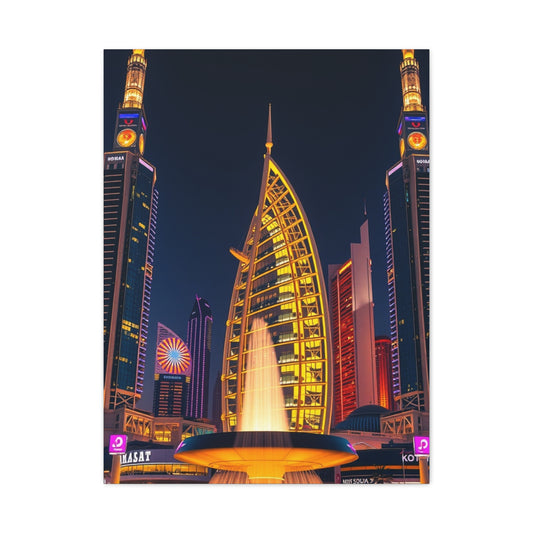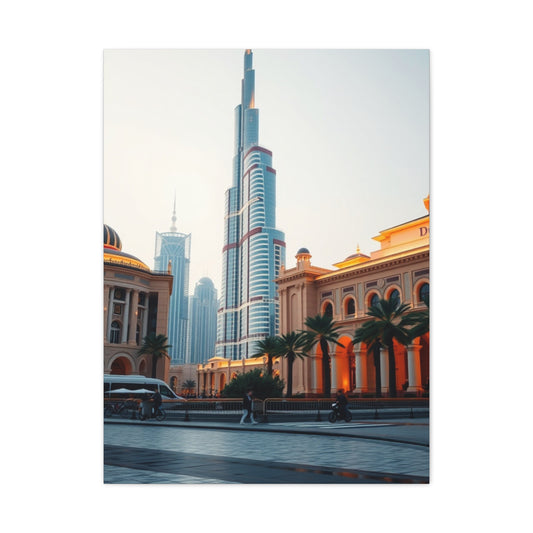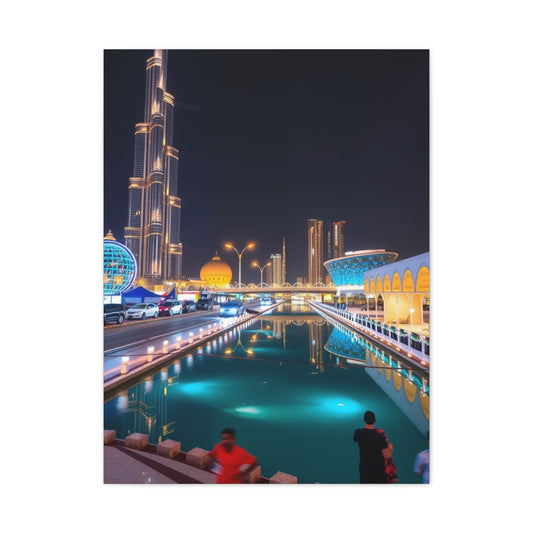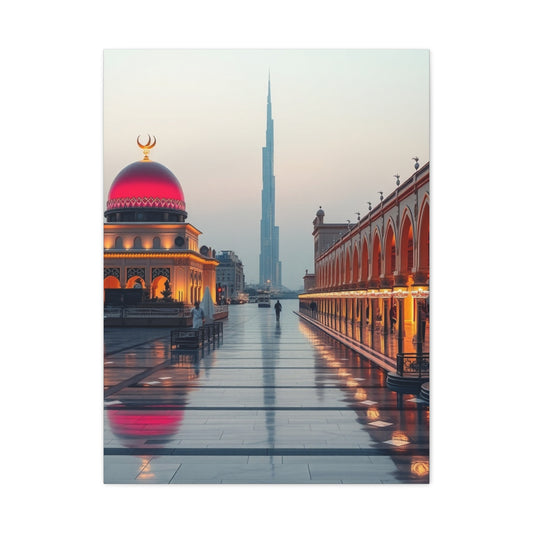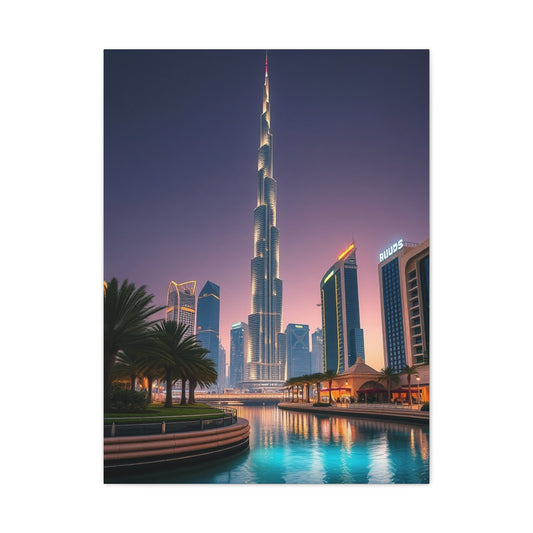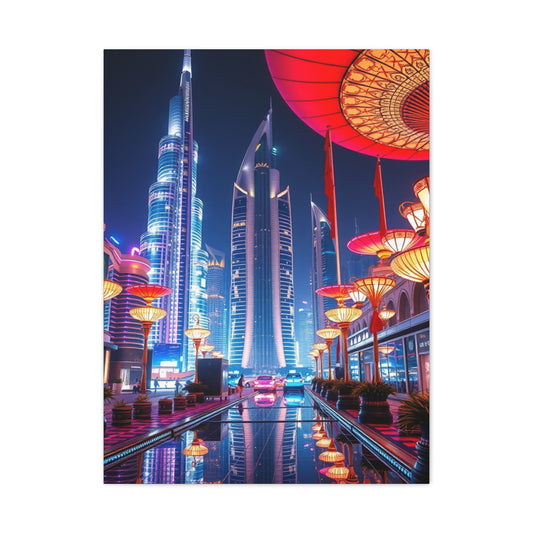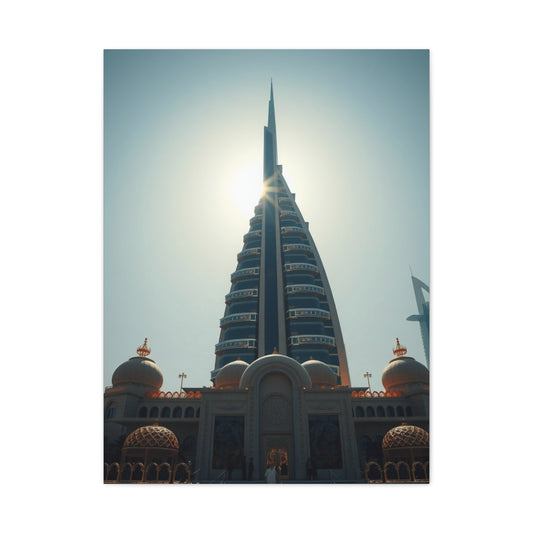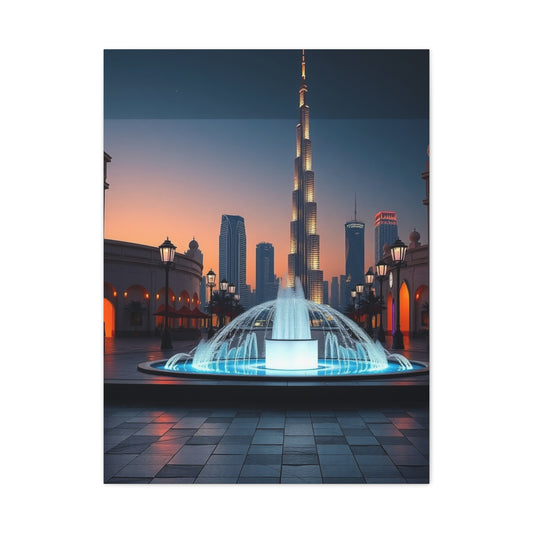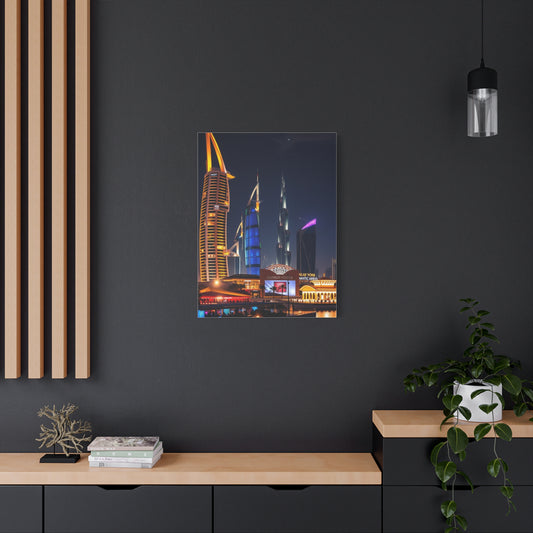Investment and Innovation Through Dubai Wall Art
Dubai, a city where gleaming skyscrapers meet timeless desert landscapes, embodies a confluence of modernity and tradition. While the metropolis is frequently celebrated for its opulent lifestyle and architectural marvels, a subtler, yet equally profound, cultural phenomenon thrives within its walls—wall art canvases. These canvases are not merely decorative; they are repositories of stories, traditions, and evolving social narratives. The city's artistic landscape reflects its capacity to amalgamate heritage with contemporary dynamism, resulting in an ever-evolving tapestry of visual culture.
The evolution of wall art in Dubai cannot be understood without recognizing the city’s dual identity. On one hand, it reveres centuries-old Emirati heritage, echoing motifs, patterns, and storytelling methods passed down through generations. On the other hand, it embraces the avant-garde, integrating global trends, abstract compositions, and digital artistry into its creative repertoire. Wall art canvases have become pivotal in this synthesis, serving as a bridge between epochs, aesthetics, and social commentary.
Wall Art as a Medium of Cultural Expression
Artists in Dubai employ wall art canvases as a versatile medium to communicate layered cultural narratives. Beyond simple visual appeal, these works articulate complex themes such as urban metamorphosis, socio-economic transitions, and the juxtaposition of tradition against globalization. In an urban milieu where skyscrapers and souks coexist, art becomes a medium through which the city reflects upon its identity.
Contemporary wall art in Dubai often integrates indigenous symbolism with modernist abstraction, creating a dialogue that is simultaneously local and cosmopolitan. Some pieces draw inspiration from desert topographies, capturing the undulating dunes in fluid strokes, while others interpret city life through geometric minimalism and color theory. This multiplicity ensures that wall art transcends mere decoration, functioning as both a contemplative and expressive tool within private and public spaces.
Transforming Interiors with Wall Art
The significance of wall art canvases extends beyond their cultural resonance; they are instrumental in shaping interior environments. In Dubai, where interiors are increasingly recognized as extensions of personal and corporate identity, wall art serves as a versatile aesthetic instrument.
A well-curated wall art canvas can redefine spatial perception, transforming an austere room into an immersive experience. For instance, expansive canvases with textured brushwork can evoke a sense of depth in compact apartments, while minimalist abstract pieces complement contemporary office spaces, fostering creativity and visual intrigue. By harmonizing color schemes, scale, and thematic content, wall art elevates interiors from mere habitation or workspaces to experiential environments.
Moreover, residents and businesses often commission bespoke artworks to articulate individuality. Custom wall art provides an avenue for patrons to embed personal narratives, cultural references, or aspirational motifs into their surroundings. Whether it is a private villa adorned with intricate Arabic calligraphy or a corporate lobby featuring a fusion of abstract and regional elements, wall art functions as a conduit for aesthetic storytelling.
The Role of Local Artists in Shaping Dubai’s Art Scene
Dubai’s burgeoning wall art culture owes much to its local artists, whose creative ingenuity sustains and evolves the city’s visual identity. These artists navigate a rich interplay of tradition and modernity, drawing from the region’s landscapes, heritage, and contemporary urban life.
Many local creators experiment with materials, textures, and techniques that extend beyond conventional painting, incorporating mixed media, metal embossing, and experimental pigments to produce multi-dimensional canvases. The resulting works are often imbued with subtle references to Emirati folklore, maritime history, or architectural motifs, producing art that resonates on multiple sensory and intellectual levels.
The city’s investment in cultural infrastructure has also catalyzed the proliferation of galleries, studios, and public exhibitions. These venues offer artists both exposure and the opportunity to engage with diverse audiences. Public installations, interactive murals, and collaborative projects further integrate wall art into the everyday fabric of the city, enabling residents and visitors to participate in and reflect upon the evolving artistic discourse.
Art as a Reflection of Societal Dynamics
Wall art canvases in Dubai do more than beautify; they mirror societal dynamics, capturing moments of transformation, aspiration, and identity negotiation. In a metropolis characterized by rapid urban expansion and demographic diversity, art often becomes a lens through which these complex social phenomena are interpreted.
For instance, some artworks explore the tension between heritage preservation and modernization, depicting traditional souks alongside soaring glass towers. Others grapple with the concept of transience, reflecting the city’s global population flux and the ephemeral nature of urban lifestyles. In this way, wall art serves as both documentation and interpretation, offering visual narratives that encapsulate Dubai’s multifaceted character.
The Interplay of Heritage and Innovation
One of the most compelling aspects of Dubai’s wall art culture is the seamless interplay of heritage and innovation. Traditional motifs, such as geometric patterns, Islamic calligraphy, and desert-inspired landscapes, coexist with contemporary abstractions, digital prints, and conceptual art. This convergence fosters a dynamic aesthetic that resonates with residents seeking a connection to cultural roots while embracing cosmopolitan sensibilities.
Artists frequently draw upon indigenous symbolism to instill a sense of belonging, while employing modern techniques to ensure relevance in a globalized context. The resulting artworks invite viewers to navigate between the familiar and the unfamiliar, creating a layered experience that challenges perception, provokes thought, and enhances the visual landscape of Dubai’s interiors.
Wall art canvases in Dubai exemplify the city’s unique capacity to blend tradition with innovation. They are more than decorative artifacts; they are cultural touchstones, narrative instruments, and reflections of societal evolution. Through the creative contributions of local artists, the strategic incorporation of wall art into interior spaces, and the embrace of heritage alongside modernity, Dubai has cultivated an artistic identity that is both distinctive and cosmopolitan.
In the contemporary cityscape, wall art continues to evolve, absorbing technological innovations, global influences, and local narratives. Its enduring presence in homes, offices, and public spaces underscores a collective recognition of art as an essential component of cultural life. As Dubai advances into the future, wall art canvases remain integral, weaving together stories, aesthetics, and social consciousness into the city’s ever-expanding visual tapestry.
Elevating Interior Spaces with Wall Art Canvases
In Dubai, where urban sophistication and architectural innovation converge, interior design is increasingly recognized as an extension of identity and lifestyle. Wall art canvases occupy a pivotal role in this domain, transforming spaces with aesthetic nuance and narrative depth. Beyond mere decoration, these artworks influence spatial perception, mood, and ambiance, rendering interiors experiential rather than purely functional.
Wall art functions as a narrative device within residential and commercial interiors alike. By strategically positioning canvases, designers manipulate visual hierarchies, direct attention, and create focal points that balance proportion, color, and light. Expansive canvases imbued with texture can produce illusions of depth, enriching compact apartments, while smaller, intricate pieces punctuate open spaces with subtle storytelling. This intentionality reflects a growing appreciation in Dubai for interior environments that resonate psychologically and culturally.
Custom Wall Art as a Reflection of Identity
In Dubai’s interior design landscape, one of the most compelling trends is the growing preference for bespoke wall art. Homeowners and businesses alike are increasingly commissioning custom pieces that capture personal narratives, cultural heritage, or aspirational motifs, transforming their interiors into reflections of individuality and taste. These artworks extend far beyond mere decoration; they imbue spaces with meaning, intention, and a sense of personal identity, making each environment distinct and memorable.
In luxury residences, custom wall art often incorporates Arabic calligraphy, desert-inspired landscapes, or abstract compositions that echo the lines, forms, and textures of local architecture. Such pieces serve as intimate storytelling devices, allowing inhabitants to embed their personal experiences, memories, and aesthetic preferences directly into their surroundings. The result is an immersive environment where walls communicate character, cultural awareness, and artistic sensibility.
Corporate spaces also benefit from bespoke wall art, which can reinforce brand identity, innovation, and professionalism. Geometric compositions, conceptual abstractions, or site-specific installations are frequently employed to convey organizational values and creative vision. By thoughtfully integrating wall art into commercial interiors, companies create atmospheres that inspire employees, impress clients, and cultivate a cohesive aesthetic narrative.
Across both residential and professional contexts, custom wall art elevates spatial experiences by combining visual appeal with emotional resonance. Each canvas becomes a focal point, a conversation starter, and a testament to the relationship between art, identity, and environment. In Dubai, this trend reflects the city’s appreciation for individuality, cultural heritage, and the transformative power of art in shaping living and working spaces.
The Psychological Impact of Wall Art
Wall art canvases exert a profound influence on human perception and emotional well-being. Studies in environmental psychology suggest that exposure to art enhances cognitive function, reduces stress, and promotes creativity. In Dubai’s fast-paced urban environment, thoughtfully curated art becomes an antidote to visual monotony, introducing visual stimuli that foster reflection, curiosity, and emotional engagement.
Color theory, texture, and composition are leveraged to manipulate mood and spatial dynamics. Vibrant, warm tones can invigorate a workspace, while subdued, neutral palettes may induce tranquility in residential settings. Similarly, abstract compositions encourage interpretation, inviting viewers to engage actively with the space. The psychological dimension of wall art underscores its significance beyond decoration, positioning it as an essential component of holistic interior design.
Local Artistic Innovation and Interior Integration
Dubai’s local artists are central to the evolution of wall art within interiors. Drawing inspiration from the city’s landscapes, cultural heritage, and cosmopolitan influences, they produce works that harmonize with diverse architectural contexts. Their experimentation with media—ranging from traditional oil paints to mixed-media installations and embossed textures—creates dynamic canvases that integrate seamlessly into both contemporary and classical interiors.
Artists frequently explore the dialogue between natural and urban motifs, juxtaposing desert vistas with cityscapes or traditional geometric patterns with avant-garde abstractions. Such duality mirrors Dubai’s unique spatial identity, allowing interiors to convey a layered narrative that is simultaneously local and universal. These integrations also highlight the city’s appetite for innovative design, where art is both a functional and symbolic element of space.
Wall Art as an Economic and Cultural Asset
Beyond aesthetic and psychological considerations, wall art canvases in Dubai represent significant cultural and economic value. Collectors and connoisseurs increasingly recognize the investment potential, as original artworks can appreciate over time. In a city positioning itself as a global hub for culture and luxury, demand for distinctive, high-quality canvases continues to rise, making art both a financial asset and a symbol of refined taste.
Ownership of wall art is often intertwined with social perception. In affluent circles, displaying original canvases signals cultural literacy, sophistication, and engagement with the arts. This cultural capital is augmented by the provenance of artworks, particularly when created by notable local artists whose works carry regional significance. Consequently, wall art serves a dual purpose: enhancing interiors while reflecting the owner’s social and cultural positioning.
Technological Advances and Wall Art
Technological innovation has expanded the possibilities for wall art in Dubai, both in creation and acquisition. Digital printing techniques now allow artists to reproduce intricate designs with unprecedented precision, broadening accessibility while maintaining visual fidelity. These methods complement traditional painting, enabling experimentation with scale, color gradients, and texture in ways that were previously impractical.
Furthermore, technology has transformed the marketplace for wall art. Online galleries, virtual exhibitions, and e-commerce platforms provide residents with immediate access to both local and international works. Augmented reality applications allow potential buyers to visualize how a piece would interact with their interiors, facilitating informed decision-making. This technological integration underscores Dubai’s embrace of innovation, extending the reach and influence of wall art beyond conventional spaces.
Wall Art as a Bridge Between Tradition and Modernity
In interior spaces, wall art canvases perform a mediatory function, bridging heritage and contemporary expression. Traditional motifs—such as Islamic geometric patterns, calligraphy, and desert-inspired textures—coexist with modern abstraction, conceptual frameworks, and digital designs. This synthesis fosters interiors that are culturally grounded yet visually progressive, reflecting Dubai’s broader societal trajectory.
Artists often employ subtle visual cues to create this dialogue. For instance, a modern abstract canvas may incorporate traditional patterning in its underlying structure, or a minimalist piece may echo local architectural forms through line and proportion. These nuanced approaches enrich interiors, inviting viewers to engage with layers of meaning while appreciating visual harmony.
Curatorial Practices and Spatial Storytelling
The integration of wall art into interiors also involves curatorial considerations. Professional designers and art consultants in Dubai increasingly adopt narrative-driven approaches, arranging canvases to guide spatial perception, create thematic coherence, and foster emotional resonance. Placement, scale, and sequencing are meticulously considered to enhance storytelling and maximize aesthetic impact.
In luxury villas, for example, a series of canvases may chronologically depict natural landscapes or cultural motifs, creating a visual journey through the residence. In corporate spaces, thematic groupings may communicate brand identity, innovation, or cultural commitment. This strategic curation elevates wall art from individual pieces to a cohesive narrative that interacts with the architecture and human experience of the space.
The Social Dimension of Wall Art in Interiors
Wall art also plays a role in social engagement within interior environments. In homes, it can spark dialogue among family members or guests, becoming a focal point for shared reflection and discussion. In commercial settings, it contributes to corporate culture, reinforcing values, inspiring employees, and enhancing client impressions. This social dimension underscores the broader significance of wall art as an instrument for communication, identity, and cultural resonance.
In Dubai, wall art canvases are far more than decorative accessories; they are integral components of spatial and cultural design. Through careful selection, customization, and curation, they transform interiors into environments that are aesthetically compelling, emotionally engaging, and socially resonant. By bridging tradition and innovation, reflecting individual and collective identity, and embracing technological advances, wall art continues to shape Dubai’s interior landscape in profound ways.
The city’s commitment to artistic integration within interiors reflects a broader cultural sensibility that values visual storytelling, innovation, and social connection. As Dubai continues to evolve architecturally and culturally, wall art canvases will remain pivotal in defining interiors that are not only functional but also narratively rich, visually stimulating, and culturally meaningful.
The Influence of Local Artists on Dubai’s Wall Art Scene
Dubai’s flourishing wall art culture owes much to the ingenuity of its local artists, whose creativity bridges tradition, modernity, and cosmopolitan sensibilities. These artists are not merely creators; they are interpreters of cultural identity, narrators of urban transformation, and experimenters with material, form, and technique. Through wall art canvases, they transform private and public spaces into arenas of visual discourse, reflecting the city’s rapid evolution and its layered social tapestry.
Local artists in Dubai draw inspiration from the juxtaposition of desert expanses and urban skylines, the interplay of light and shadow across sand dunes, and the intricate geometries found in Islamic architecture. These motifs often intermingle with contemporary abstraction, conceptual frameworks, and global artistic trends, producing works that resonate both locally and internationally. The resulting pieces are rich with nuance, offering audiences an immersive aesthetic experience while also prompting contemplation of the city’s identity.
Cultural Narratives in Wall Art
Wall art canvases in Dubai frequently serve as vehicles for cultural storytelling. Artists embed symbolism, motifs, and historical references within their compositions, creating visual narratives that echo the Emirati heritage while engaging with contemporary societal concerns. Some canvases explore maritime history, traditional crafts, or folklore, while others address themes of urbanization, migration, and globalization.
By integrating these narratives into accessible visual formats, artists cultivate a dialogue between the past and present. Residents and visitors alike can encounter cultural knowledge in unexpected spaces, from luxury residences to corporate lobbies, galleries, and public installations. This democratization of cultural storytelling underscores the centrality of wall art in Dubai’s artistic ecosystem.
The Role of Government and Institutions
Dubai’s support for the arts has catalyzed the city’s emergence as a global cultural hub. Government initiatives, public funding, and institutional infrastructure provide artists with platforms to create, exhibit, and commercialize their work. Galleries, exhibitions, and cultural festivals offer visibility and foster community engagement, while public art programs integrate wall art into urban planning and civic spaces.
These measures not only enhance the visibility of local talent but also encourage experimentation and interdisciplinary collaboration. Artists often engage with architects, interior designers, and urban planners to integrate wall art seamlessly into spaces, creating immersive environments that fuse function and aesthetics. The resulting works contribute to a culturally vibrant cityscape where art is intertwined with everyday life.
Public Art and Urban Identity
Wall art in Dubai extends beyond interiors into public spaces, shaping the city’s identity and communal experience. Murals, large-scale installations, and site-specific artworks transform streets, plazas, and parks into cultural landmarks. These public canvases foster social interaction, civic pride, and cultural literacy, making art a participatory rather than a passive experience.
Public wall art also facilitates cross-cultural dialogue, reflecting Dubai’s diverse population and global connections. Artworks often incorporate multiple languages, symbols, and narratives, creating a visual lexicon that is inclusive and multilayered. By embedding culture into the urban fabric, wall art reinforces Dubai’s reputation as a city that celebrates creativity, diversity, and innovation.
Wall Art as a Societal Mirror
Artists in Dubai often utilize wall art to reflect broader social dynamics, capturing shifts in lifestyle, demographics, and urban development. Canvases may depict the tension between tradition and modernity, the interplay of wealth and labor, or the transitory nature of urban life. In doing so, art becomes both documentation and commentary, offering viewers insight into societal trends while fostering critical reflection.
For example, some works juxtapose traditional Emirati architecture with contemporary skyscrapers, highlighting the rapid evolution of the city. Others explore the experiences of expatriate communities, rendering narratives of migration, adaptation, and cultural negotiation. Through these visual interventions, wall art becomes a lens through which the complexities of Dubai’s society are interpreted, questioned, and celebrated.
Innovation and Experimentation in Local Art
Dubai’s local artists are known for pushing the boundaries of technique, medium, and concept. Beyond traditional painting, many explore mixed media, digital integration, and experimental textures. Canvases may incorporate layered materials, metallic pigments, or interactive elements, resulting in multidimensional experiences that engage multiple senses.
This experimentation is not merely aesthetic; it also reflects Dubai’s ethos of innovation and ambition. By combining heritage with avant-garde methods, artists produce works that are intellectually stimulating, visually arresting, and culturally resonant. The interplay of materials, scale, and technique ensures that wall art remains a dynamic and evolving aspect of the city’s cultural identity.
Art as Investment and Status Symbol
In Dubai, wall art canvases extend far beyond their aesthetic appeal, embodying both economic and social significance. Original artworks, particularly those created by renowned local artists, are increasingly perceived as valuable investment assets, often appreciating in monetary worth over time. Collectors and art connoisseurs actively seek pieces that are not only visually captivating but also culturally resonant and unique in their conception. This duality—where an artwork provides both emotional and visual satisfaction while representing potential financial gain—positions wall art as a sophisticated form of asset ownership.
Beyond its investment potential, wall art functions as a marker of cultural refinement and social prestige within Dubai’s affluent society. The possession and display of distinctive canvases signal an individual’s engagement with the arts, an appreciation for craftsmanship, and an alignment with contemporary cultural currents. In private residences, wall art transforms interiors into curated spaces that reflect personal taste, values, and identity. In professional or corporate environments, it conveys creativity, sophistication, and an awareness of broader artistic trends, reinforcing an organization’s cultural and intellectual ethos.
This confluence of aesthetic beauty, economic value, and social symbolism underscores the multifaceted importance of wall art in Dubai. Original canvases are not merely decorative; they are statements of status, investment, and cultural engagement. By combining visual impact with financial and symbolic significance, wall art continues to hold a prominent place in the city’s artistic, social, and economic landscape, bridging personal expression with societal recognition.
The Technological Dimension of Artistic Creation
The integration of technology into the creative process has further expanded the possibilities for local artists. Digital tools enable precision, reproducibility, and experimentation, allowing complex designs, gradients, and interactive elements to be realized on canvas. Augmented reality and virtual exhibition platforms also allow artists to reach global audiences, offering immersive experiences without geographical constraints.
Technology does not replace traditional methods but complements them, enhancing creativity and broadening the scope of artistic expression. By embracing digital techniques alongside conventional painting, sculpting, and mixed media, Dubai’s artists maintain a balance between innovation and authenticity, ensuring that wall art canvases continue to evolve in form and function.
Community Engagement Through Art
Wall art also fosters community engagement, creating opportunities for dialogue, collaboration, and cultural participation. Collaborative murals, public workshops, and artist residencies encourage residents to interact directly with creative processes, demystifying art and making it an accessible part of daily life. These initiatives cultivate a sense of ownership and pride, reinforcing the notion that art is not merely observed but experienced collectively.
Schools, cultural centers, and public institutions increasingly incorporate wall art into educational and social programs, using visual storytelling to convey history, identity, and civic values. By embedding art into communal experiences, local artists contribute to a culturally literate society that values creativity, reflection, and shared expression.
The Lasting Influence of Local Artists
Local artists in Dubai have established wall art as a vital component of the city’s aesthetic and cultural identity. Their contributions extend beyond the canvas, influencing interior design, urban planning, public engagement, and social dialogue. By synthesizing heritage, contemporary perspectives, and technological innovation, these artists ensure that wall art remains relevant, dynamic, and meaningful.
As Dubai continues to grow and diversify, the role of local artists will become even more central. Their capacity to interpret, innovate, and communicate through wall art canvases ensures that the city’s visual culture evolves alongside its urban and social landscape, fostering a sense of continuity, identity, and creative vitality.
Wall art canvases in Dubai transcend decorative function, serving as cultural catalysts that shape interiors, public spaces, and societal perception. Through the work of local artists, these canvases encapsulate heritage, innovation, and social narrative, reflecting the city’s complex identity and dynamic evolution.
The integration of art into everyday life—whether through residential interiors, corporate environments, or public installations—underscores the enduring importance of wall art as a medium of communication, reflection, and engagement. Dubai’s local artists, with their innovative approaches and culturally resonant works, continue to redefine the possibilities of wall art, ensuring its place as a cornerstone of the city’s artistic and cultural landscape.
The Role of Technology in Wall Art
In Dubai, where innovation permeates architecture, lifestyle, and commerce, technology has become a transformative force in the creation, distribution, and appreciation of wall art canvases. Digital tools, software, and printing techniques have expanded the boundaries of artistic possibility, allowing artists to explore intricate designs, experiment with scale, and integrate multimedia elements into their work.
Digital printing, for instance, enables precise reproductions of complex textures, color gradients, and patterns, making high-quality wall art accessible to a broader audience. Artists can translate elaborate sketches or digital concepts into tangible canvases without compromising fidelity, ensuring that their creative vision is preserved in physical form. These advances also allow for experimentation with materials, enabling surfaces that respond to light, texture, and movement in dynamic ways.
Virtual Galleries and Online Platforms
Technology has also reshaped how residents and collectors interact with wall art. Virtual galleries and online marketplaces provide immediate access to diverse collections from both local and international artists. Augmented reality applications allow users to visualize pieces in their homes or offices, adjusting scale, orientation, and placement before purchase. This convergence of digital tools and art democratizes access, enabling enthusiasts to engage with artworks regardless of location or logistical constraints.
Moreover, these platforms facilitate global recognition for Dubai-based artists. Digital exhibitions, online auctions, and virtual showcases amplify the reach of wall art, connecting creators with collectors, institutions, and audiences worldwide. Technology thus not only enhances artistic creation but also transforms the ecosystem of appreciation, collection, and curation.
The Investment Value of Wall Art
Wall art canvases in Dubai are increasingly recognized as financial as well as aesthetic assets. Original works, particularly those by prominent local artists, are viewed as long-term investments with the potential for appreciation. The city’s growing reputation as a cultural hub enhances this value, attracting collectors seeking unique, culturally resonant pieces.
Beyond financial considerations, ownership of distinctive wall art conveys social and cultural capital. In Dubai’s affluent society, displaying original canvases reflects sophistication, taste, and engagement with contemporary creative currents. This dual significance—monetary and symbolic—reinforces the importance of wall art within private collections, corporate spaces, and public installations alike.
Digital Art and Contemporary Expression
The emergence of digital art has further expanded the scope of wall art in Dubai. Artists now integrate digital painting, graphic design, and interactive elements into physical canvases, producing works that are simultaneously modern and culturally anchored. This synthesis of digital and traditional media enables new forms of expression, where interactivity, light, and dynamic imagery enhance visual and conceptual impact.
Digital techniques also support experimentation with color, scale, and layering. Artists can manipulate virtual models before finalizing a piece, exploring multiple iterations and visual effects without committing to irreversible materials. This flexibility encourages innovation, allowing creators to challenge conventions and produce distinctive works that resonate with diverse audiences.
The Intersection of Aesthetics and Innovation
Wall art in Dubai exists at the intersection of aesthetics, culture, and technological innovation. Canvases integrate traditional motifs with contemporary abstraction, blending historical reference with forward-looking design. Technological tools amplify this synthesis, enabling precision, scale, and complexity that were previously unattainable.
This integration produces artworks that are not only visually striking but intellectually stimulating. Abstract compositions may subtly reference geometric patterns from Islamic art, desert landscapes, or city architecture, creating layered experiences that reward careful observation. In this way, wall art becomes a medium of exploration, reflection, and aesthetic enrichment.
Public Engagement and Interactive Art
Technology has also facilitated interactive and participatory forms of wall art. Installations incorporating motion sensors, projection mapping, or digital overlays allow viewers to engage directly with the artwork. In public spaces, these interactive canvases encourage exploration, dialogue, and communal experience, transforming passive observation into active participation.
Such innovation aligns with Dubai’s ethos of experimentation and progress, where creativity and technology converge to redefine traditional art forms. Interactive wall art not only captivates audiences but also fosters cultural engagement, inviting residents and visitors to become co-creators in the artistic experience.
Cultural Preservation Through Technology
While technology enables modern experimentation, it also supports the preservation and reinterpretation of cultural heritage. Digital techniques allow artists to archive traditional patterns, motifs, and designs, ensuring their continuity while integrating them into contemporary canvases. This approach maintains a dialogue with history, bridging past and present in visually compelling ways.
Through these efforts, wall art serves both as a record of heritage and as a platform for innovation. Digital tools enhance accessibility, allowing traditional aesthetics to reach wider audiences, while also empowering artists to reinterpret cultural symbols in ways that resonate with modern sensibilities.
Wall Art as a Status Symbol and Cultural Statement
In Dubai, owning wall art has significance beyond visual appeal. Original canvases, especially those by notable local artists, convey cultural sophistication and social status. Displaying these works communicates an engagement with the arts, a connection to heritage, and an appreciation for innovation and design.
The symbolic value of wall art extends to corporate environments as well. Offices and commercial spaces that feature distinctive canvases project professionalism, creativity, and cultural awareness. This dual function—both aesthetic and symbolic—underscores the multidimensional importance of wall art in shaping perceptions and identity within the city.
The Future of Wall Art in Dubai
As Dubai continues to evolve as a global cultural hub, wall art canvases are poised to play an increasingly central role in the city’s artistic, social, and economic landscapes. The interplay of traditional motifs, contemporary abstraction, and technological innovation ensures that artworks remain dynamic, relevant, and engaging.
Future trends include greater integration of interactive digital elements, environmentally sustainable materials, and cross-disciplinary collaborations with architecture, interior design, and urban planning. These developments will expand the possibilities for creative expression, audience engagement, and cultural preservation.
Wall art canvases in Dubai encapsulate the city’s dual embrace of heritage and innovation. Through technology, digital experimentation, and the creativity of local artists, these artworks continue to evolve, enriching both private and public spaces. They function as aesthetic enhancements, cultural narratives, social statements, and investment assets, reflecting the multifaceted significance of art in the urban experience.
Dubai’s ongoing commitment to integrating art into everyday life—from luxurious interiors to public spaces, digital platforms, and interactive installations—ensures that wall art remains a vital component of the city’s identity. As the metropolis grows and transforms, wall art canvases will persist as enduring symbols of creativity, cultural dialogue, and aesthetic sophistication, shaping how residents, visitors, and global audiences experience and understand the city.
Conclusion
Dubai’s affinity for wall art canvases reflects a nuanced interplay of culture, innovation, and aesthetic sophistication. Across the city’s private residences, corporate spaces, galleries, and public areas, wall art transcends mere decoration, functioning as a conduit for cultural storytelling, personal expression, and societal reflection. From intricate geometric patterns rooted in Islamic heritage to contemporary abstractions inspired by urban dynamism, canvases in Dubai illustrate a seamless dialogue between tradition and modernity, offering viewers layered visual experiences that are simultaneously familiar and forward-looking.
Local artists play a pivotal role in shaping this landscape. Their creativity, informed by the city’s desert vistas, architectural marvels, and cosmopolitan ethos, imbues wall art with both intellectual depth and emotive resonance. By integrating heritage motifs, experimental techniques, and digital innovations, these artists produce works that are as culturally anchored as they are globally relevant. Public installations, collaborative murals, and interactive canvases extend this influence beyond interiors, engaging residents and visitors in shared experiences that foster cultural literacy and civic pride.
Technology has further transformed the realm of wall art in Dubai. Digital printing, augmented reality, and virtual galleries enhance artistic precision, accessibility, and reach, allowing audiences to interact with and acquire art in innovative ways. Simultaneously, the integration of technology preserves cultural motifs, facilitates experimentation, and expands creative possibilities, ensuring that wall art remains both timeless and contemporary.
Moreover, wall art functions as a symbol of social status, cultural awareness, and economic value. Collectors and connoisseurs recognize its potential for appreciation, while interior designers and architects harness its transformative power to shape spaces that are emotionally engaging and visually compelling. The combination of aesthetic, cultural, and financial significance positions wall art as an indispensable component of Dubai’s urban and social fabric.
In essence, wall art canvases are the heartbeat of Dubai’s creative identity. They embody the city’s ability to harmonize heritage with innovation, individual expression with collective culture, and aesthetic beauty with societal meaning. As Dubai continues to evolve as a global cultural hub, wall art will remain a vital thread in its vibrant tapestry, enriching spaces, inspiring communities, and celebrating the enduring dialogue between art, technology, and human experience.

